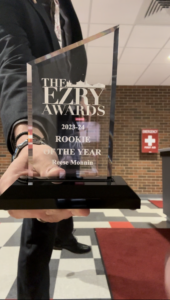Wittenberg faculty and staff have recently shared concerns about the impact that the new Health, Wellness and Athletic Complex will have on the university in coming years as the bill continues to rise for the project. The current estimate for the project has reached $52.8 million, an increase from previous estimates of $40 million nearly eight months ago.
On Oct. 24, Jonathan Eilert, chair of the Wittenberg Board of Directors, sent an email to faculty and staff updating them on the process and costs of the project after breaking ground in March.
The project, first proposed in Nov. 2015, outlined a total cost of an estimated $30.6 million facility. In the coming months, both the Springfield News-Sun and Dayton Daily News updated audiences on donations and rising costs of the facility. In Oct. 2016, the cost of the project was then at an estimated $40 million.
Paul Loscheider, Interim Vice President for Finance and Administration, outlined the current costs, accurate as of Nov. 28. The Board of Directors has approved borrowing of $34 million, $15.4 of which Loscheider anticipates will be paid for by tax credits.
“We anticipate based on good sources of information that we will get those tax credits,” Loscheider said.
Although faculty and staff have shared concerns over borrowing money to complete the project, Loscheider said the project could not be stopped, even with much fundraising still to be achieved, without costing substantially more in the future.
“When you are selling fundraising for buildings, you are selling something that will be valuable in the future, but something that is based off of history,” Loscheider said.
Loscheider even mentioned that the Board of Directors have increased their committed amount to the project, with 100 percent of the Board making donations toward the building.
German professor Timothy Bennett said that, at first, he was seemingly neutral with the building of the facility.
“I wasn’t thrilled, but I was somewhat neutral because we were promised repeatedly that the university would not break ground until all of the funding had been secured,” Bennett said.
History professor Amy Livingstone, on the contrary, was quite thrilled about the athletic facility.
“I think I had a slightly different reaction than some of my colleagues,” Livingstone said. “When this was proposed, I wasn’t as upset or saw this as something not helpful to retaining students as some of my other colleagues did. I was reassured by the promises that were made about not breaking ground until funds were raised, not taking out loans, it not affecting the operating budget and not affecting future campaigns.”
Although Bennett’s feeling toward the HWA facility has changed after costs have risen, he says the project cannot be turned back.
“They’ve promised the moon, and because of this, they are afraid,” Bennett said. “Not going ahead with it sends a message that the institution is in trouble.”
In 2015, Wittenberg ran into further financial issues during then-President Laurie Joyner’s reign. Cuts were proposed for a number of majors, and, due to this financial crisis, 26 faculty members lost their jobs. Health insurance as well as retirement plans have also dropped in amount of coverage.
“It’s like we were just healing and they said, let’s go get infected again,” Bennett said.
When costs reached $52.8 million, Livingstone realized that a critical error had been made in estimating the finalized costs of the project, what has now been termed the “$18 million oopsie.”
“We are held accountable for every penny we spend at Wittenberg, yet we are able to have somebody in charge of this project who presumably has a background for this project, which went doubly over,” Livingstone said. “The incompetence is breathtaking, even for Wittenberg.”
After briefly surfacing from these financial troubles, Bennett shared concerns about assuming debt to build the facility.
“Wittenberg is just surfacing from a prolonged financial crisis,” Bennett said. “The result of the crisis was, in my opinion, the weakening of the academic program across the board. We’re now preparing to assume debt again for a facility that seems to be metastasizing, it seems to exceed any need on campus, in my opinion, and that will continue to weaken programs and undercut the quality of the education.”
Bennett listed a variety of impacts he sees coming for faculty and staff.
“I’m afraid that they will talk about program elimination, salaries will continue to stagnate, and insurance costs will continue to rise,” Bennett said.
Livingstone echoed many of the same concerns, while also adding that she was concerned about the consequences that faculty and staff will have to face, but not the Board of Directors.
“The members of the Board will move around, but the fact of the matter is that this isn’t going to affect them,” Livingstone said. “They won’t have to get up in the morning and deal with the reality of Wittenberg.”
In the faculty meeting, Frandsen provided a broad outline for the project, as well as addressing other concerns with the Board of Directors. Although students, other than elected representatives, were unable to attend, Bennett mentioned that faculty and staff were frustrated with the rising costs and implications of the facility on the way faculty do their jobs.
“There’s a level of frustration and dissent that I’ve not witnessed in my more than 30 years here,” Bennett said. “But often it’s the faculty and the staff who give their entire professional life to a single institution and so they are long terms stakeholders in the place. When there is such deep dissatisfaction and bewilderment in a faculty, it’s very troubling.”
As the project continues, Bennett wishes that the project would be diminished, literally, to not only accommodate the athletic department, but to ease strain on Wittenberg’s budget.
“I would rather they build something that they could afford to build,” Bennett said.
Livingstone agreed, wishing that the facility would be reduced in size to place Wittenberg in a better financial situation.
“My preference, and I don’t know what the financial implications are… I would agree with Bennett,” Livingstone said. “The impulse to create a better HWA was fair and legitimate, and if it had progressed the way it was supposed to, stay on budget; I would have been fine with that.”
In response to these comments, Loscheider said that reducing the size of the building is nearly impossible at this stage of the process.
“If you cut back the size of the building, you cut the program tremendously and you may not get as much out of it in many respects,” Loscheider said. “What’s planned for the building, based on the drawings, is that we’ve got more space for academics and a better space for athletics.”
These plans include three new classrooms along with a multi-purpose room, plus an exercise science room. Along with these rooms for academics, both professors and members of the athletic department will receive brand-new offices.
Livingstone shared concerns of Wittenberg becoming too far out of the price-range for many students, driving prospective students to other schools because of the high price tag for Wittenberg.
“We are going to price ourselves out of the ballgame,” Livingstone said. “It would be nice to have a decent wage, and it would be nice to be paid the same as my other liberal arts colleagues are getting paid. But, the Board decided we should build a new athletic facility without thinking about the professors.”
Loscheider, on the contrary, thinks of the addition of the HWA facility as a positive.
“There’s a belief in Wittenberg and what it can do for Wittenberg, and what Wittenberg can do for its students,” Loscheider said. “The benefits that we anticipate coming from completing this building will outweigh the costs, but it might take some time and that’s the real key.”





